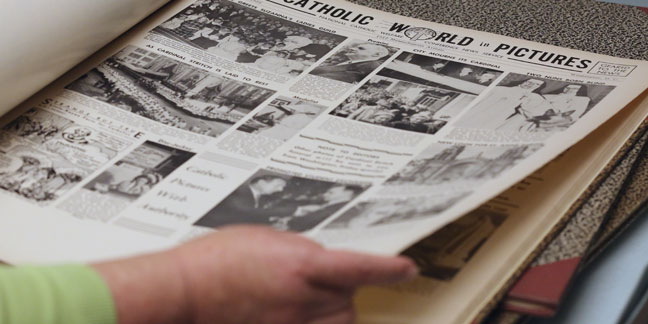 WASHINGTON, D.C. — Only pack rats would save copies of old newspapers. Or so you would think.
WASHINGTON, D.C. — Only pack rats would save copies of old newspapers. Or so you would think.
But a consortium of librarians and archivists are preserving the Catholic news from the last century.
As newspapers age, their pages get more brittle and fragile. And outdated technologies such as microfilm and microfiche keep those newspapers from being readily accessible unless you live near a big downtown library or a university that still has the machines needed to read that data.
Many Catholic newspapers, unlike their secular daily brethren, were not kept, maintained and preserved with the same level of passion, save for some diocesan archives.
To correct this situation, the Catholic Research Resources Alliance has undertaken a project to digitize nearly a dozen of the United States’ top Catholic newspapers of regional and national importance – the print runs of which, for some of them, go back for more than a century.
“Creating a Catholic news archive and digital aggregation for Catholic newspapers is something that scholars are very interested in,” said Jennifer Younger, executive director of the alliance, known as CRRA.
“We mark the beginning (of the project) in 2011, when we brought together a newspaper committee: ‘If we’re going to digitize something, what would be most useful?’ Newspapers rose right to the top. Which newspapers? We had to figure out which newspapers existed, which ones were being held (by libraries), which ones weren’t being held,” she said.
The committee came up with a list of more than 800 Catholic publications from the United States alone, and another 200-plus in Canada.
Eleven newspapers the digitization project has begun with represent some of the largest dioceses in the nation: Catholic New York of the Archdiocese of New York; the Catholic Standard and Times of the Archdiocese of Philadelphia; Catholic San Francisco; the Clarion Herald of the Archdiocese of New Orleans; the Florida Catholic of the Archdiocese of Miami; the St. Louis Review; the Pittsburgh Catholic; and the Catholic Transcript of the Archdiocese of Hartford, Conn.
A 12th newspaper recently added to the list is the Catholic Worker, which since its founding in the 1930s is still a penny a copy, as the front-page banner says.
For a national perspective, the National Catholic Reporter and 65 years’ worth of newsfeeds starting in 1920 from what is now called Catholic News Service will be digitized. CNS’ predecessor was NCWC, for National Catholic Welfare Council. In addition, an NCWC/CNS feature called “Catholic World in Pictures” will be digitized too.
The digitized material will be made freely available through the CRRA-developed Catholic News Archive, www.thecatholicnewsarchive.org.
Digitization is the new normal, according to Tim Meagher, an associate professor of history at The Catholic University of America, Washington, and an archivist who runs the Center for American Catholic History.
“Everything is, as much as possible, going into digital format,” Meagher said. “In some ways, even if the paper exists in print, its use will be less if it is not digitized.”
Some of the largest U.S. dailies, including the New York Times, Washington Post and Chicago Tribune, have been digitized, he said. “It’s a tremendous asset,” Meagher added. “Suddenly you’re on the radar screen, easy to access, easy to get to.”
Of Catholic papers, he said, “We would love to be able to digitize every one. We may not be able to digitize all of them, we may not be able to digitize all years. But to begin is an important thing.”
“We have set very high standards. When we do our digitization, we never have to do it again,” said Patricia Lawton, CRRA’s director of digital initiatives. “We’re getting the best imaging we possibly can. Microfilm or print, you want a good image. That is the basis of everything that you’re going to do,” allowing the user to employ more robust search capabilities. “We based all our research on the Library of Congress (standards) and even upped the standards a bit,” Lawton noted.
Archivists also are working with those libraries and diocesan archives holding newspaper collections to preserve them, and to provide multiple backups for the digital information being created.
— Mark Pattison, Catholic News Service
More online
Check out the complete digital archives of the Catholic News Herald, from its founding in 1991 to present


